Earlier in the week I covered this 1958 Packard and opined about the state of affairs that brought what was arguably the finest domestically produced automobile (Ask the man who owns one), to a rather ignoble end. Well, before the downward slope got slipperier Packard was assembling cars like this 1950 Eight Touring sedan. It’s a bit forlorn looking and appears to be wearing a South Florida-hued Earl Schieb paint job but I don’t want to be judgemental, so let’s give this Packard sedan a fair shake. It’s located in Orlando, Florida and is available, here on craigslist for $8,850, OBO.
Packard offered two models in ’50, a Deluxe Eight and Standard Eight editions, both spread across two or four-door sedan body styles. Total production slumped considerably, however, with just 42K units putting Packard in fifteenth place. It’s notable as just one year prior they managed to muster an output of 117K copies – ouch! That’s a big decrease.
So, I might have been a bit snarky with the Earl Schieb paint comment but this aqua-blue paint job is very un-Packard-like. It’s flat, faded, peeling, and missing in places due to surface rust. The body, however, looks pretty solid and appears to be free of crash damage or measurable rot-through. As the seller notes, all of the stainless trim looks like it’s still in place. Oddly, the rear bumper’s chrome plating seems to be worse than that of the front – I generally encounter the reverse.
The interior is a mixed bag as it’s missing the front door panels, but there is what looks like a relatively sound carpet in place. The steel dashboard is tarnished with surface rust but the seating upholstery isn’t too bad. The instrument panel is more restrained than I would have thought with the center portion of the dash, just to the right of the gauge pod, being dominated by a large chrome-plated radio speaker grille – a common feature in cars of this era. It looks like the seller has added under-dash auxiliary gauges.
A 135-gross HP, 288 CI “straight-eight” engine gives this Packard its freedom of movement. Other than a new six-volt generator, the totally out-of-place yellow spark plug leads, and an open-element air cleaner that looks like it’s wearing a hat, the engine appears to be untouched – mileage not disclosed. The seller claims, “Run and stop as it chute be” which I think means as it should. A three-speed manual gearbox handles gear changes.
To me, the last of the line ’58 Packard 58L is a lot more interesting than this sort of a blimp, Dick Tracy-era car. While that ’58 is hardly the first thing that comes to mind when I think Packard, I can’t say that this ’50 edition does either. The seller suggests, “You can choose to restore it, hot rod it Rat rod it or live it patina as it“. I won’t bother translating but my vote with a car like a Packard is to always restore it to its original condition. But that’s just me, what’s your suggestion?
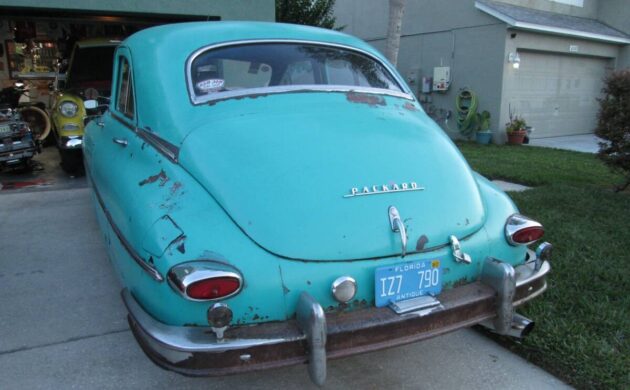
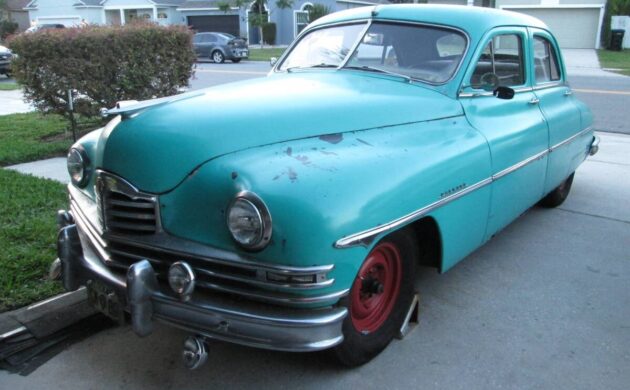
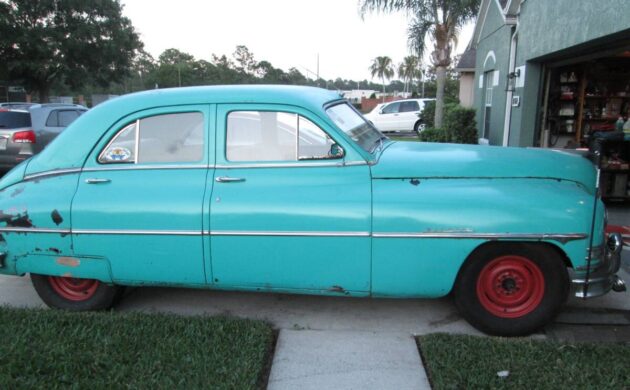
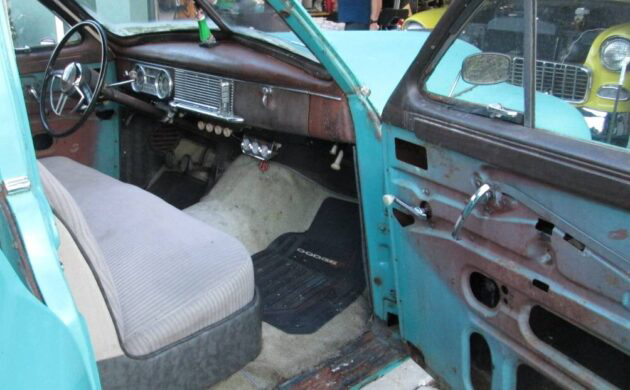

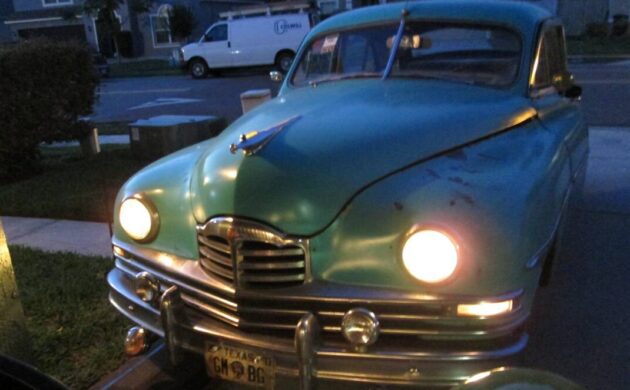




Another great write up. Never ceases to amaze me all the creativity you writer’s are blessed with. Thanks for your hard work. Weren’t these nicknamed “bathtubs”.
Yep. Several other models as well had bath-tub styling in the late 40’s.
Porsche joined the bath tub club too.
They were also called the “Pregnant Elephant” due to the blimpish shape. Not a very endearing nickname to say the least, but when you mention a pregnant elephant, car people automatically know what years of Packard you are referring to.
I think the Nash cars were dubbed “bathtubs”. I gotta laugh…who would hot rod a 1950 Packard? 1/4 miles times?
yes, and what patina is the owner talking about? A bad paint job is not patina.
A very rare find especially in original ” unrestored” condition ! The sixty- four thousand dollar question is : where are you going to find replacement parts for a 1950 Packard ? The last one I saw was way back in 1972 and there weren’t many around even before then . Restoring one may be years in the making .
Mark,
There are numerous companies supplying Packard parts, and easy to find thru the Packard Club’s publications.
On his show, ” Full Custom Garage,” Ian Roussel made a sweet custom out of one of these for one of his buddies, keeping it a 4 door so his friend’s kids could enjoy cruising in it. Below is a link to the partially done car. It’s not always about a fast car- sometimes it’s about a stunning, rolling work of art.
https://m.media-amazon.com/images/M/MV5BMmI4ZTg3YzctZjJmMC00ZjBmLWFmMzYtYzRhMDAzNGEwM2M0XkEyXkFqcGdeQXVyNjc0Njg0NDM@._V1_FMjpg_UX1024_.jpg
The finished car:
https://i.pinimg.com/originals/60/6a/b3/606ab342c2d3f372eee9c575489f2453.jpg
Really looks impressive! I’m in awe of somebody that can figure out how to do something like that…and then make it happen! I think it’d look better with all the brightwork on the front remaining chrome, but that’s just me!
Gotta love a Packard with Dodge Lancer wheel covers.
Never did get to see the finished two door with the sloped back.
Prolly low 12s! Mine has 135 hp and weighs 5200 lbs.
12 secs to get to the starting line?
Yes, Nash Airflow.
I like the rear 3/4 view a lot. Not sure what to do the make the front more appealing. For the price, though, why not? Make up some door cards and drive it around until the inspiration hits you.
Maybe go full bathtub and source a set of moon discs. Of a few more driving lights up front like a Panamerica car.
12 secs to get to the starting line?
Those Accel plug wires are good for 50 horsepower.
Looks like it made it over with the big Cuban immigration!This is my favorite generation of all the Packards. And it might have overdrive!
My Dad had a black one just like this except it had overdrive. One night we were going to try and find his wallet he had lost driving on a rural highway. He had it up to 95 and had not even let off the gas to engage the overdrive. Said he didn’t know what overdrive was.
I’ve got one of these sitting right outside my door! It’s done (except for getting the gas gauge fixed. Considering what I gave for it, and how much I spent on it to get it in good shape, I’d say the one for sale is worth about $3K.
Texas plates in the front and Florida plates in the back. There’s a joke in there somewhere.
Is that a padlock securing the trunk lid?
Back in the 60s they were also called “Potato Bugs” and they were already scarce on the road then. Nash of the same vintage was generally referred to as Bathtubs. There can’t be more than just a handful of these old Packads left that run and drive. Most were scrapped a long time ago
I have distinct memories of riding in a brand new Packard when I was about 5 years old. This was 1951. No idea of why or who, but I learned much later that some relative of mine was a Packard dealer. I always loved this era of Packards.
Is this Chrisfl’s car?
J. O.,
For the 23rd series [late 1949 into 1950] Packards, there were a total of 5, not 2, levels of Packards [not including the VERY rare 6 cylinder Packard taxicab, as they were not available to the public*]: The model lines included:
Standard 8
Deluxe 8
Super 8
Super Deluxe 8
Custom 8
The Standard 8 like the car shown, was the base model. The Deluxe 8 had a few more creature comforts like a folding rear seat center armrest, and a slightly better material on the seats along with buttons.
The Super 8 was built on the longer 127″ wheelbase but had the 327 engine instead of the bigger 356. The grill bars in the main center grill were curved like the forward edge of an airplane wing, with the outer grill assembly just like the Super Deluxe and Custom 8 cars. I had one of these cars in the mid 1970s, equipped with the Ultramatic. My car was terribly underpowered.
The Super Deluxe 8 cars were also built on the 127″ wheelbase, and had the more opulent Custom 8 full broadcloth interior, available in 4 colors; Blue, green, tan and maroon. But they still had the mid-level 327 engine, and potential buyers found these cars were also very underpowered.
The Custom 8 was almost identical to the Super Deluxe 8 except it had the big 9-main bearing 356 engine, and the Ultramatic transmission was standard equipment.
* The Packard taxicab was not sold by Packard Motor Car Company [PMCC], they were handled by Packard Federal Corp., who handled all Packard commercial sales and export sales. I was fortunate to interview Bob King, Jr. in 1973. Bob and his father ran Packard Federal until it was closed by PMCC in 1951. Bob said PMCC only sold 6 cylinder LWB Packard taxicabs for the 23rd series, to honor an order from a major NYC taxicab company placed in 1947. Those 23rd series taxicabs were only produced in a LWB version that met the New York City taxicab specifications to provide up to 5 passengers in the rear seating area.
Forgot to include a rare color photo of a long wheelbase Packard taxicab in New York City.
Will try loading that photo again . . .
Thanks for your always insightful & knowledgeable comments, Bill. The 6-cylinder Packard taxicab must have been horribly underpowered although perhaps it wasn’t apparent in NYC traffic. A ring job on a 1949 Packard 8 was my first experience with internal engine repair. It was successful.
Robert,
Packard wisely equipped the LWB Packard NYC Taxicabs with a very high numerical rear axle ratio. If I remember correctly, it was a 4.56 to 1. Their max speed was about 45mph, but even the NYC parkways were still limited to 25mph.
About 5 years ago I was attending the Packard Club national meet in South Bend, Indiana, and the Packards were permitted to drive around the former Studebaker-Packard proving ground’s oval test track. I was a passenger in a 1947 Packard taxicab sedan, that had been ordered with overdrive because the car was used in a rural location. While it took a while, the owner of the taxi was able to coax his car up to almost 100mph, with 6 people in the car. Not bad for a little 245 CI flathead 6!
Bill, as I remember the story New York City passed a law that said passengers couldn’t ride in the front of the cab with the driver. Packard and DeSoto both came out with a long wheelbase car that had two rows of seats behind the driver. In the DeSotos the 2nd row seat was identical to the front seat, with the 3rd row seats kinda “Jumpseat-ish”. Had luggage rack on top because the 3rd row took part of what should have been trunk space. I guess the Packard was built on the limo chassis?
Henry,
This photo shows a rare overhead shot of both DeSoto and Packard NYC taxicab examples, with a passenger in the Packard’s front seat. The event was the April 7, 1949 premier of the hit Broadway show South Pacific at the Majestic Theater.
NYC taxicabs typically had full front seats and if so equipped could seat 1 or 2 passengers up front. That said, many were equipped with what was known as the “Partition cab” where the driver was separated from the rest of the interior. In the area to the driver’s right, 2 options were available; Just an area for luggage, or a fold down seat with the rider facing rearward if no luggage space was needed.
NYC developed what became the most stringent set of rules in the world for taxicabs. Even things like requiring the opening rear door windows to be bordered with metal — no bare edges on the glass panes. This was because passengers often slammed the door hard enough to crack unsupported glass in the rear doors. The rear door openings also had to be lined with an extra large windlace that had a foam core. This was done to help keep passenger fingers from becoming crushed when a door was closed.
One main reason few NYC Taxicabs survive today is because they had rubber mats on the floor, with holes drilled in the steel floor so the cars could be “hosed out” with a water hose! This resulted in the floors rusting out within a year or 2.
NYC also required access to fresh air ventilation during hot summer days. The older Model Y Checker taxis accomplished this with a steel roof section over the back seat that could be lowered. DeSoto installed a sliding curved AS-1 glass sunroof, and Packard installed a vacuum powered opening rear window. These can both be seen in the above photo in front of the theater. {[y the time the new Checker A-8 taxicab was introduced in 1956, this fresh air clause was no longer required, so they didn’t need a sunroof or opening rear window.]
One of the reasons for the 3rd row jump seats on the DeSoto cabs was because NYC regulations forbid placing any luggage inside the trunk. DeSoto used the area for seating, but few were equipped with the rooftop luggage rack as offered on the postwar all steel DeSoto Suburban their taxicab was based on. Packard came up with a special steel cage that only allowed the spare tire and tire tools to be kept in the trunk, and they added a folding trunk rack. You can see the trunk rack in the above photo, and if you look closely you can see the rear window open/close brackets
In the first photo you can also see the additional horizontal steel bumper guards to protect the rear fenders & taillights. There were additional bumper brackets, held on by additional chrome bumper bolts. Because the center areas of bumpers on the 22nd series Packards were painted body color, this makes it possible to see all the additional bumper bolts.
Due to the heavy body of the Packard limousine being combined with the 6 cylinder motor, a numerically high rear axle was installed, making the top speed of the NYC taxicab limited to about 45mph. Under the hood Packard used the huge Custom 8 [356] radiator, mounted behind the front body crossmember instead of in front of the crossmember. This was possible because the 6 cylinder engine was not as long. Packard also used the Custom 8 clutch assembly, gearbox, brakes and suspension.
In the hopes of amortizing costs on this special 141″ wheelbase chassis, Packard introduced the Super 8 “Business limousine” and LWB sedan cars in late 1949, with a total of 1,260 cars sold, however only 192 were the Business limo. The LWB sedans proved popular with funeral homes and upscale hotel use.
In 1972 I discovered a 1948 Packard Taxicab sedan that had never been used as a taxi, and was still in the hands of the original owner, Charles Robey, who worked for Diamond Cab Co in Washington DC. At the time, Charles was unable to buy a new car due to the long wait for cars, so Diamond Cab agreed to sell him one of their new cabs. Since then 2 more taxi sedans have been discovered, and a club member in the mid west has found a genuine NYC Taxicab, and it’s currently under restoration. It’s believed to be the only one left.
I had a 1951 Packard 200 that had the same flathead straight 8. While it could cruise at 85, the owner’s manual required an oil change every 1,000 miles and the valves frequently needed attention, or it would run a little rough.
Jonathan Apgar,
The oil change frequency was not due to the Packard engine, it was due to the state of engine oils in 1951. Most car manufacturers had the same requirements back then, as oils didn’t last as long.
As for the valves requiring frequent attention, It’s likely the valves were not correctly adjusted. Packard valve specifications expected the engine to be fully warmed up to ensure they were adjusted correctly. My shop has had Packard cars [and other makes] come in with a similar situation, and we found the person who adjusted the valves did it when the engine was cold. The most common reason given for cold adjustment was the valve adjustment access was just above & behind the exhaust manifold and they didn’t want to burn their arms!
A typical post-war junior Packard with adjustable valves won’t need adjustment until 40,000 or more miles. I’ve had Packard eights with over 200,000 miles that never had a valve adjustment.
Looks like a good vehicle to run shine, if one was inclined. Speaking of space, not 1/4 mile times.